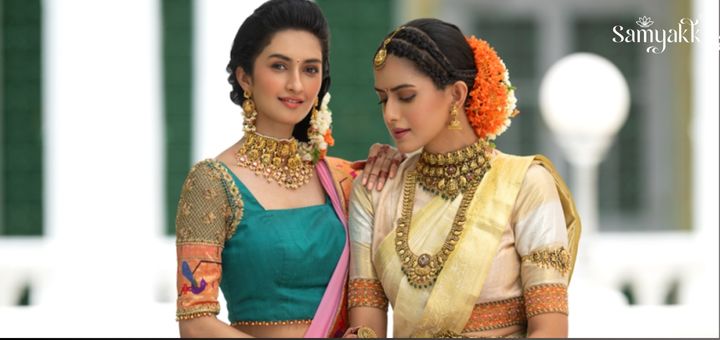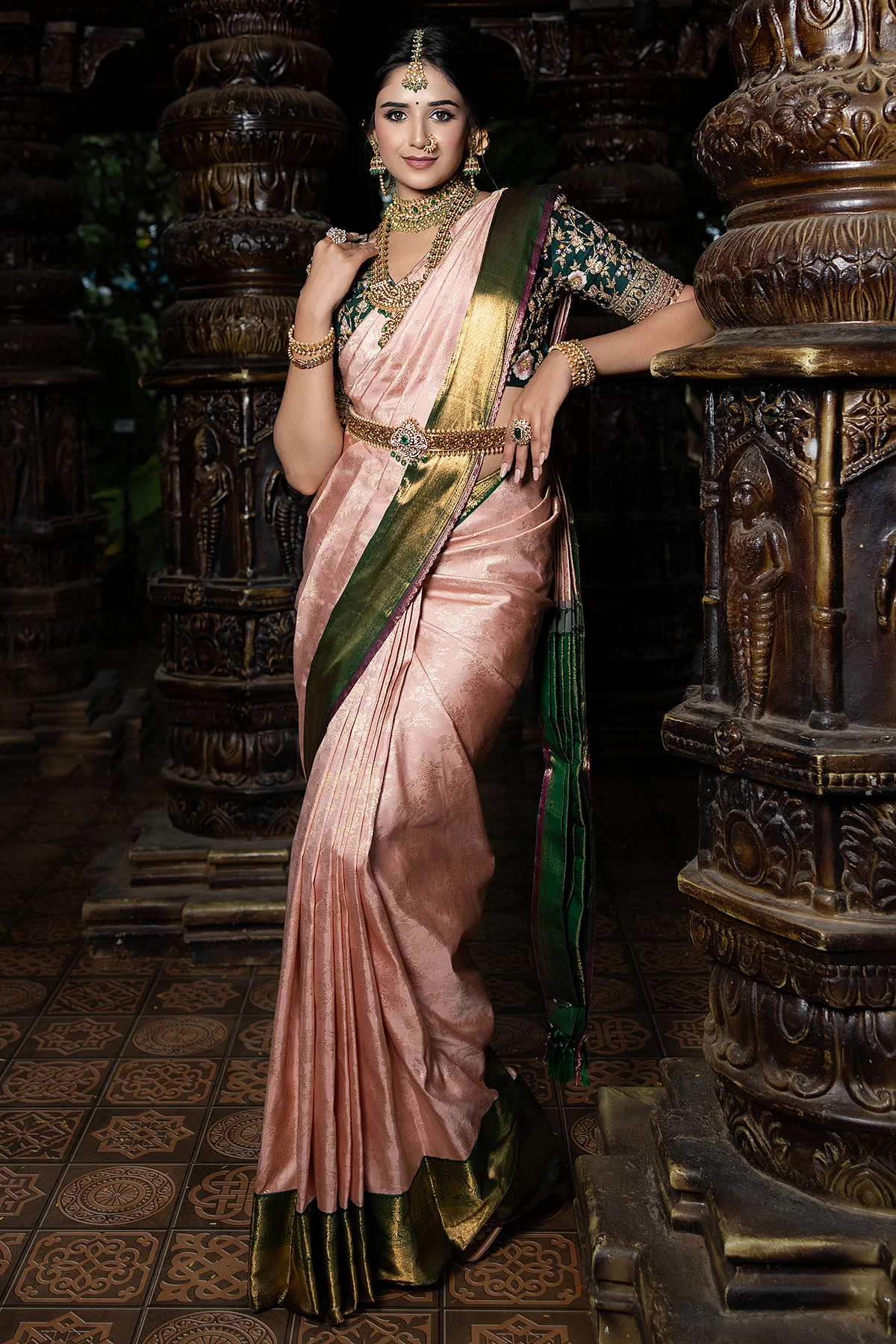India is a land of vibrant cultures, and its diversity is beautifully reflected in the traditional attires worn across the country. From north to south, east to west, every state has its own unique sartorial identity. These traditional outfits are not just fabrics but also symbols of the country’s deep-rooted heritage, history, and customs. Let’s explore ten timeless traditional attires of India, each representing a unique cultural tapestry.
1. Tamil Nadu: The Iconic Silk Saree
One of the most renowned traditional attires from Tamil Nadu is the Kanchipuram silk saree. Known for its durability and rich designs, this saree is often adorned with intricate patterns of temple borders, checks, stripes, and floral motifs. Kanchipuram silk has been woven for over four centuries and holds great significance in South Indian weddings. Each saree is handwoven with pure mulberry silk and zari (gold or silver thread), making it not just an attire but a prized possession passed down through generations.
2. Kerala: The Elegant Kasavu Saree
From the lush landscapes of Kerala comes the elegant Kasavu saree, also known as the settu saree. Characterized by its white or off-white hue with a golden border, the Kasavu saree symbolizes grace and simplicity. Traditionally worn during the festival of Onam, it is also a favorite for weddings. The gold-bordered attire reflects the beauty of Kerala’s culture and heritage.
3. Rajasthan: The Colorful Ghagra Choli
In the royal deserts of Rajasthan, women adorn the ghagra choli, a colorful ensemble often paired with an odhni (veil). The ghagra (long skirt) is made with vibrant, bold colors that reflect the spirit of Rajasthan’s lively culture. Mirror work, embroidery, and intricate threadwork are common features, making it a head-turning traditional attire that symbolizes the state’s rich folk traditions.
4. Gujarat: The Rich Patola Saree
Hailing from Gujarat, the Patola saree is a masterpiece in the art of weaving. Known for its double ikat technique, Patola sarees are luxurious and can take months to craft. With bold geometrical patterns and vibrant colors, these sarees are worn on special occasions, especially by brides. The intricate craftsmanship has earned Patola sarees a global fanbase, adding to Gujarat’s rich textile tradition.
5. Punjab: The Graceful Salwar Kameez
The salwar kameez is synonymous with Punjab and is one of India’s most versatile traditional attires. The salwar (loose pants) paired with the kameez (long tunic) is comfortable yet stylish. The Patiala salwar suit, with its flared bottoms and short kurta, is a popular version often worn by Punjabi women. This outfit reflects the energetic and vibrant spirit of Punjab.
6. West Bengal: The Regal Baluchari Saree
In the eastern state of West Bengal, the Baluchari saree is a staple for festive occasions, especially during Durga Puja. These sarees are known for their intricate motifs, often depicting mythological scenes woven into the fabric. The Baluchari saree holds a regal stature, and its elaborate weaving process ensures that each saree is unique and filled with cultural narratives.
7. Assam: The Traditional Mekhela Chador
Assam’s mekhela chador is a two-piece garment that is draped similarly to a saree but has a distinct structure. Made from Assam’s famous silks like Muga silk and Pat silk, this attire is elegant and lightweight, perfect for the humid climate of Assam. The mekhela chador is often worn during Bihu, the Assamese harvest festival, symbolizing the region’s rich handloom heritage.
8. Maharashtra: The Nauvari Saree
Maharashtra’s nauvari saree stands out for its unique draping style. This saree is wrapped around the legs, similar to a dhoti, allowing freedom of movement. Traditionally worn by women in the Maratha warrior communities, the nauvari saree represents strength and grace. Today, it is worn during festivals, weddings, and cultural events.
9. Karnataka: The Elegant Mysore Silk Saree
The Mysore silk saree from Karnataka is renowned for its luxurious feel and minimalistic elegance. These sarees, crafted from pure silk, are known for their smooth texture and sheen. Often adorned with golden zari, they are a must-have for bridal trousseaus and special occasions. The Mysore silk industry dates back to the reign of the Maharajas, making it a timeless piece of Karnataka’s heritage.
10. Odisha: The Timeless Sambalpuri Saree
From Odisha comes the beautifully woven Sambalpuri saree. Famous for its unique Bandha (tie-dye) technique, the saree often features traditional motifs like conch shells, flowers, and wheels, representing Odisha’s rich culture. Sambalpuri sarees are celebrated for their fine craftsmanship and have gained global recognition for their intricate handloom process.
Why Traditional Attire is Still Relevant
Despite the growing influence of western fashion, traditional Indian attire remains relevant. These timeless outfits have evolved with the times, blending effortlessly into contemporary wardrobes. Fusion fashion, which combines traditional and modern elements, has also played a significant role in keeping these attires fashionable. Indo-western dresses, lehengas with modern cuts, and sarees styled in unique ways are becoming increasingly popular.
Conclusion
India’s traditional attires are more than just garments; they represent the heart and soul of the country’s diverse cultures. Each outfit tells a story of its region, with rich textiles, intricate craftsmanship, and symbolic significance. Whether it’s the elegance of the Kanchipuram saree or the bold colors of the Rajasthani ghagra choli, these timeless attires have a special place in Indian fashion. To explore more of India’s stunning traditional wear, you can find exquisite collections at Samyakk.
Frequently Asked Questions (FAQs)
- What makes Kanchipuram sarees so special?
Kanchipuram sarees are known for their durability, intricate designs, and pure silk material. They are handwoven and often include motifs inspired by temples and nature, making them prized possessions.
- Can traditional attire be worn at modern events?
Absolutely! Many people mix traditional and contemporary styles, wearing sarees or lehengas with modern blouses or accessories at weddings, parties, and even corporate events.
- How do you style a nauvari saree for contemporary occasions?
You can style a nauvari saree with a modern blouse, experiment with different draping styles, and accessorize with statement jewelry for a fresh look.
- What is the difference between a ghagra choli and a lehenga?
A ghagra choli is more common in Rajasthan and is usually worn with a veil (odhni). A lehenga is a broader term for a long skirt paired with a choli (blouse), popular across India.
- Where can I find authentic traditional Indian clothing?
For authentic, high-quality traditional Indian attire, you can explore collections at Samyakk, known for its exquisite craftsmanship and diverse range of traditional outfits.
Also Check Out:-


